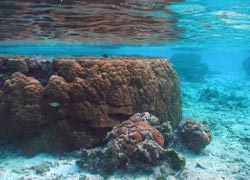What is El Nino Taimasa?

This shows flat-top Porites coral on a shallow reef near American Samoa. Coral heads are fully submerged under normal conditions. During El Niño Taimasa, tops of large flat coral on the reef are exposed to air at low tide.<br><br>Credit: Image courtesy of the National Park of American Samoa.<br>
The Samoans call the wet stench of coral die-offs arising from the low sea levels “taimasa” (pronounced [kai' ma'sa]). Studying the climate effects of this particular variation of El Niño and how it may change in the future is a team of scientists at the International Pacific Research Center, University of Hawai'i at Mānoa and at the University of New South Wales, Australia.
Two El Niño Taimasa events have occurred in recent history: 1982/83 and 1997/98. El Niño Taimasa differs from other strong El Niño events, such as those in 1986/87 and 2009/10, according to Matthew Widlansky, postdoctoral fellow at the International Pacific Research Center, who spearheaded the study.
“We noticed from tide gauge measurements that toward the end of these very strong El Niño events, when sea levels around Guam quickly returned to normal, that tide gauges near Samoa actually continued to drop,” recalls Widlansky.
During such strong El Niño, moreover, the summer rain band over Samoa, called the South Pacific Convergence Zone, collapses toward the equator. These shifts in rainfall cause droughts south of Samoa and sometimes trigger more tropical cyclones to the east near Tahiti.
Using statistical procedures to tease apart the causes of the sea-level seesaw between the North and South Pacific, the scientists found that it is associated with the well-known southward shift of weak trade winds during the termination of El Niño, which in turn is associated with the development of the summer rain band.
Looking into the future with the help of computer climate models, the scientists are now studying how El Niño Taimasa will change with further warming of the planet. Their analyses show, moreover, that sea-level drops could be predictable seasons ahead, which may help island communities prepare for the next El Niño Taimasa.
At Ocean Sciences 2014
PROJECTIONS OF EXTREME SEA LEVEL VARIABILITY DUE TO EL NIÑO TAIMASA, Oral presentation Session #:079 Rising Sea Level: Contributions and Future Projections; Date: 2/26/2014; Time: 12:00; Location: 313 B; http://www.sgmeet.com/osm2014/viewabstract.asp?AbstractID=15569
Authors
Widlansky, M. J., University of Hawai'i at Manoa, USA, mwidlans@hawaii.edu
Timmermann, A., University of Hawai'i at Manoa, USA, axel@hawaii.edu
McGregor, S., University of New South Wales, Australia, shayne.mcgregor@unsw.edu.au
Stuecker, M. F., University of Hawai'i at Manoa, USA, stuecker@hawaii.edu
Chikamoto, Y., University of Hawai'i at Manoa, USA, chika44@hawaii.edu
Public Information Officer
Gisela Speidel, Outreach Specialist, International Pacific Research Center; gspeidel@hawaii.edu; tel. – (808) 956-9252
Publication Citation:
Widlansky, M.J., A. Timmermann, S. McGregor, M.F. Stuecker, and W. Cai, 2014: An interhemispheric tropical sea level seesaw due to El Niño Taimasa. J. Climate, 27 (3), 1070-1081, doi:10.1175/JCLI-D-13-00276.1.
Media Contact
More Information:
http://www.hawaii.eduAll latest news from the category: Earth Sciences
Earth Sciences (also referred to as Geosciences), which deals with basic issues surrounding our planet, plays a vital role in the area of energy and raw materials supply.
Earth Sciences comprises subjects such as geology, geography, geological informatics, paleontology, mineralogy, petrography, crystallography, geophysics, geodesy, glaciology, cartography, photogrammetry, meteorology and seismology, early-warning systems, earthquake research and polar research.
Newest articles

Properties of new materials for microchips
… can now be measured well. Reseachers of Delft University of Technology demonstrated measuring performance properties of ultrathin silicon membranes. Making ever smaller and more powerful chips requires new ultrathin…

Floating solar’s potential
… to support sustainable development by addressing climate, water, and energy goals holistically. A new study published this week in Nature Energy raises the potential for floating solar photovoltaics (FPV)…

Skyrmions move at record speeds
… a step towards the computing of the future. An international research team led by scientists from the CNRS1 has discovered that the magnetic nanobubbles2 known as skyrmions can be…




















